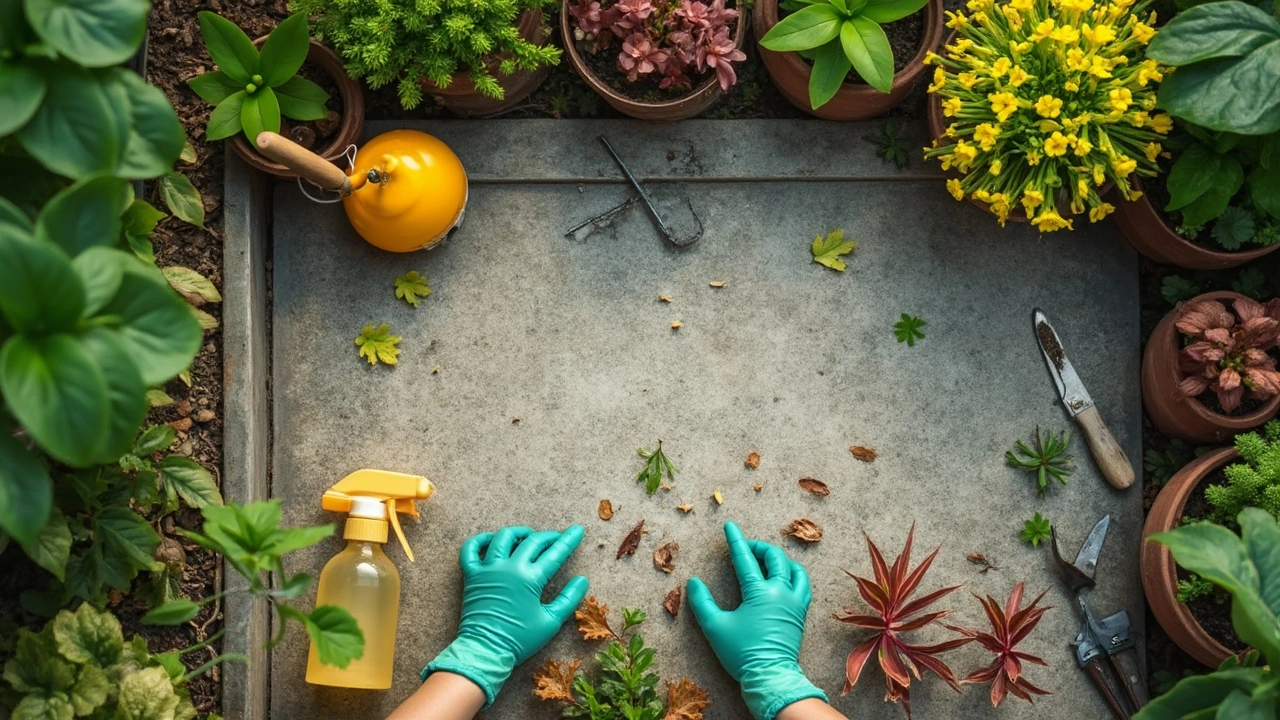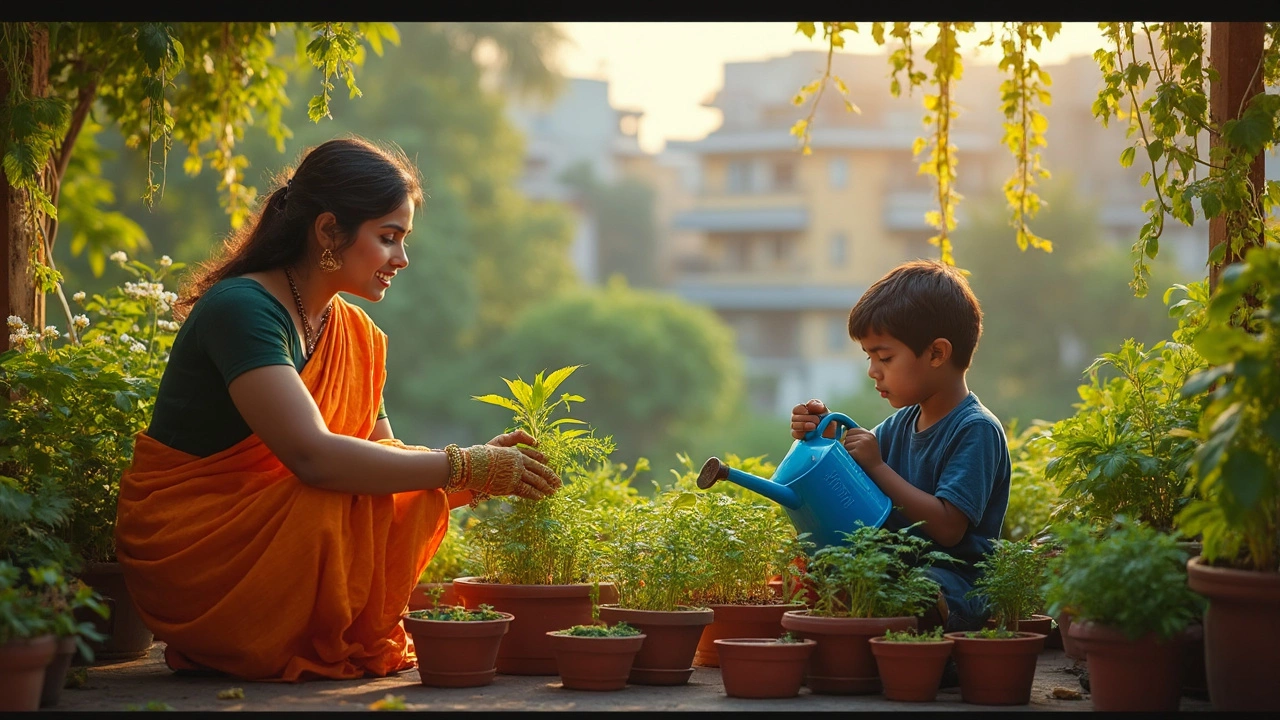If you’ve ever tried to enjoy your morning coffee on a terrace covered with dried leaves and mossy stains, you already know: maintenance isn’t just a chore, it decides if your terrace feels inviting or neglected. And honestly, letting things slide means double the work (and cost) later on. Start with the basics—sweep regularly, don’t let fallen petals turn into mushy stains, and give railings a quick wipe every now and then. Even unstained tiles can turn slippery when ignored for too long.
It isn’t just about looks. Sick plants, clogged drains, and hidden pests have a way of sneaking up on lazy gardeners. My friend once ignored a tiny crack in her tile—fast forward six months, and guess what? Major water damage, just because a little maintenance seemed like ‘extra’ work. Bottom line: small, regular upkeep keeps headaches away and leaves you more time to chill on your terrace instead of turning into the local repair expert.
- Cleaning and Surface Care
- Plant Upkeep and Pruning
- Watering and Drainage Hacks
- Spotting Pests and Common Issues
Cleaning and Surface Care
Don’t underestimate regular cleaning—this is what stops your terrace from turning into a moldy, slippery mess. Dust, pollen, bird droppings, and even leftover soil are just waiting to build up. If you ignore them, your flooring can stain permanently or get dangerous to walk on after it rains. The trick is to keep up with quick cleans instead of waiting until the weekend when it feels impossible.
Sweeping should be a twice-a-week habit. Go for a stiff-bristled broom; soft ones can’t budge wet leaves or stuck-on dirt. When it comes to deeper cleaning, warm soapy water is usually enough for concrete tiles or any standard outdoor flooring. But if you spot black or green patches (that’s algae and moss), grab a scrub brush plus a mild bleach-water mix. Only use this where plants and pets won't touch—it’s strong stuff. For wooden decks, pick a wood-friendly cleaner instead and reseal once a year to stop rot. Broken tiles or chipped edges? Fix them early before water sneaks in and makes things worse.
- Wipe terrace railings with a damp cloth and mild detergent to prevent rust or dust build-up, especially after heavy rain.
- Use a pressure washer yearly, but skip it if you have old or delicate surfaces—it can do more harm than good.
- Check for clogged drains every week. If you see pooling water after rain, act fast; standing water invites mosquitoes and ruins your flooring.
Here’s a quick look at just how fast things can build up if ignored:
| Problem | How Fast It Appears (if not cleaned) |
|---|---|
| Moss/Algae Growth | 2-3 weeks in rainy season |
| Permanent Stains | 1-2 months with daily use |
| Clogged Drains | 3-7 days after heavy plant shedding |
| Rust on Railings | 1 month, especially in humid climates |
Regular terrace maintenance really does save you from spending hours scrubbing or worse—dealing with repairs later. Just ten minutes here and there keeps your outdoor space looking good and safe for everyone who uses it.
Plant Upkeep and Pruning
If you think plants on a terrace just need water and a little sun, you’re missing half the story. Keeping your plants trimmed and healthy is hands-down one of the best ways to avoid trouble later. Overgrown leaves block sunlight from smaller plants, and dead stems can invite mold or even bugs. Good pruning also encourages new growth, so your terrace looks fuller and fresher without cramming in new pots every season.
Here’s what works for most terrace gardens:
- Check for dead, yellow, or droopy leaves every week. Cut them off with clean scissors to prevent rot.
- Snip back leggy stems—those are the long, bare-looking ones—because they waste energy and crowd out healthy parts.
- For flowering varieties, pinch off wilted blooms (that’s called deadheading). This keeps the plant focused on making more flowers instead of wasting energy on seeds.
- Watch out for roots peeking out of the bottom: that’s a cry for repotting. Roots winding around inside their pot can choke the plant, so move them up a size when needed.
Regular plant care is the heart of terrace maintenance. Catching issues early saves money on replacements and keeps everything looking alive, not just ‘barely surviving.’ Most people don’t realize: if you skip on regular pruning, some plants (like tomatoes or basil) can shrink your harvest by half or more. One Indian gardening survey found that monthly pruning raised yields by up to 35% for common terrace crops.
| Plant Type | How Often to Prune | What to Remove |
|---|---|---|
| Herbs (basil, mint) | Every 3 weeks | Dead leaves, flower heads |
| Flowering plants (petunia, marigold) | Weekly | Wilted blooms, stray stems |
| Climbers (money plant, jasmine) | Monthly | Leggy stems, tangled vines |
One last tip: Never toss cuttings with diseases or bugs into your regular compost—unless you want a mini pest invasion. Bag them up and trash them, or burn if local rules allow. Simple habits like these are what actually keep your terrace looking sharp month after month.

Watering and Drainage Hacks
Problems with watering trip up even experienced terrace gardeners. Too much water turns your pots into swamps, but skip a day or two in summer and you’ll find droopy, sad leaves. Here’s the low-down: most plants need water when the top inch of soil dries out (stick your finger in and check—it’s easier than guessing). Set a manageable schedule. During hot spells, water in the mornings so soil can absorb moisture before the sun gets brutal.
Drainage makes or breaks terrace gardens. If your pots don’t have drainage holes, drill some. No exceptions! Soggy roots spell disaster for most plants. Elevate pots with bricks or old tiles so water actually flows out instead of pooling underneath. Check every few weeks that drainage holes aren’t blocked by mud or roots.
- Self-watering planters help if you travel or forget (but don’t put every plant in them—some hate constant moisture).
- Line trays with small stones to keep pots out of standing water.
- Group thirstier and drier-loving plants separately; it makes watering less confusing.
Never ignore terrace-specific challenges. With concrete or tiled floors, water can pool and cause slippery spots or leaks downstairs. Sloped flooring is best, but if your terrace isn’t sloped, use shallow trays and mop up any standing water promptly.
| Common Issue | Quick Fix |
|---|---|
| Pot water not draining | Check holes, raise pots, clear blocks |
| Plants wilting mid-day | Water earlier, add mulch, provide afternoon shade |
| Stains on tiles | Place catch trays, clean drains regularly |
| Downstairs water seepage | Seal cracks, avoid heavy watering after rain |
Remember, smart terrace maintenance isn’t about using more water—it’s about using it right and giving water somewhere to go. Check your setup, test for slow drains, and make sure you’re not just watering your floor instead of your garden.
Spotting Pests and Common Issues
Pests and little problems show up on every terrace garden at some point—even if you scrub your pots twice a week. Here’s the thing: it’s way easier (and cheaper) to fix issues when they’re small. If you see white spots on leaves, sticky residue, or little bugs crawling under pots, don’t just hope they go away. These are classic signs of trouble.
Keep an eye out for the usual suspects: aphids, spider mites, mealybugs, and ants. Aphids look like tiny green or black dots bunched up on young shoots. Spider mites leave fine webs and turn leaves yellowish. Mealybugs show up as fuzzy white stuff near the stem joints, and ants usually mean there are sucking bugs around providing them with free snacks.
- Check the undersides of leaves every few days, especially during hot, dry spells. This is where most pests hide.
- Move a few pots around every month to spot hidden nests or root issues. Spongy soil and stunted growth can mean root rot or grubs.
- Yellowing or droopy leaves aren’t always thirst or sun problems—it can also be early pest trouble or bad drainage.
Sometimes, small holes or mushy spots on wooden railings and planters point to termites or fungal growth. Early intervention keeps your *terrace maintenance* from turning into a full renovation project.
| Pest | What You’ll See | Easy Fix |
|---|---|---|
| Aphids | Clusters on new growth, sticky leaves | Blast with water, use neem spray |
| Spider Mites | Fine webbing, yellow leaves | Wipe leaves, spray with soapy water |
| Mealybugs | White cottony patches | Dab with alcohol on a cotton swab |
| Ants | Lines of ants, often around other pests | Clear pests, sprinkle cinnamon as barrier |
If you see a rise in pests, cut back on chemical fertilizers—the soft new growth attracts even more bugs. Instead, keep airflow going, let soil dry out between watering, and use natural fixes first. Catching problems early means fewer chemicals, happy plants, and that satisfying feeling of staying ahead of a crisis.




